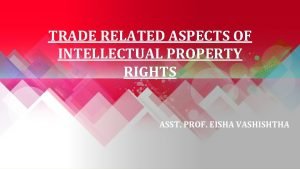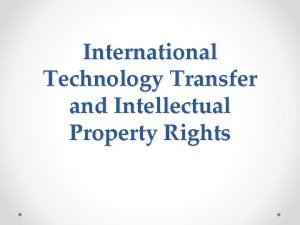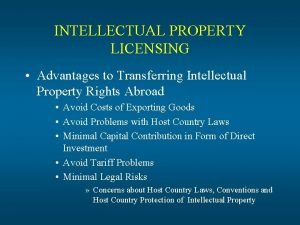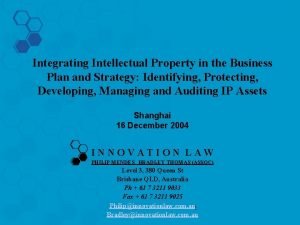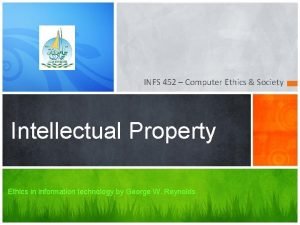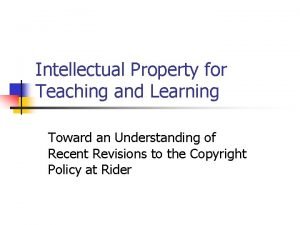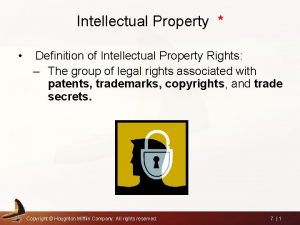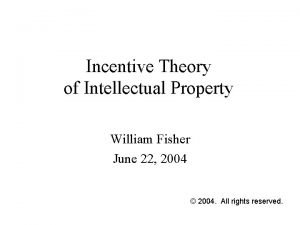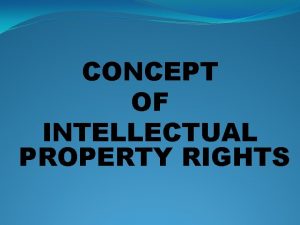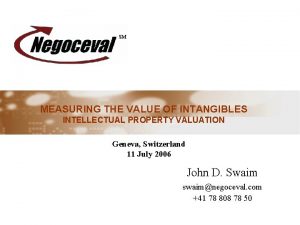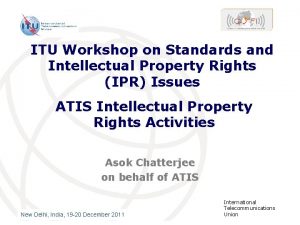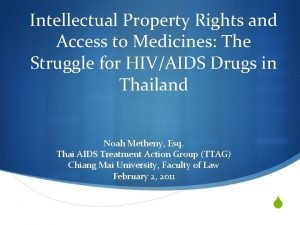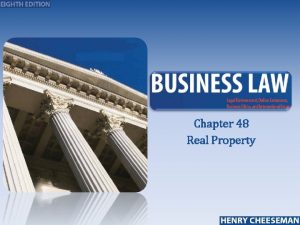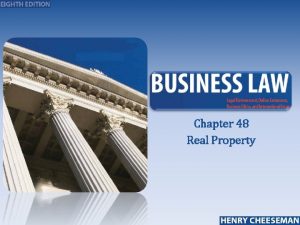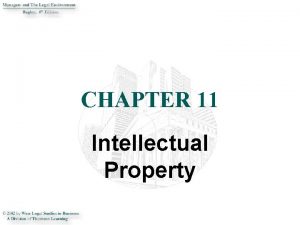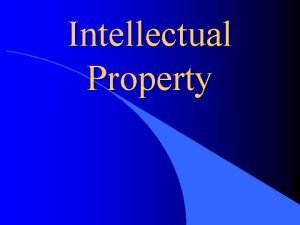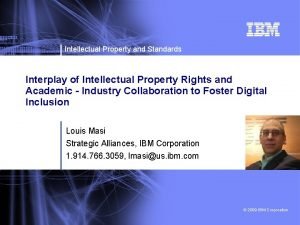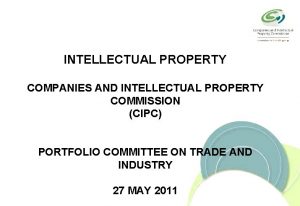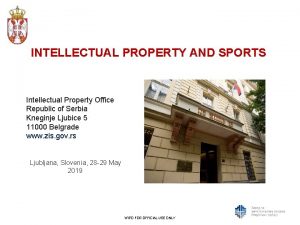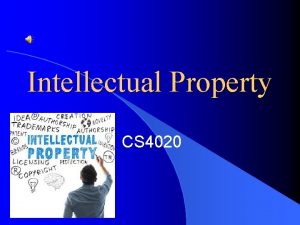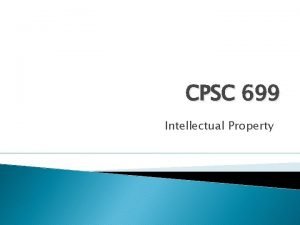Property and Intellectual Property Chapter 9 Real Property















- Slides: 15

Property and Intellectual Property Chapter 9

Real Property • Land – under - oil, minerals – attached - buildings, trees, crops • Property - “legally protected expectation of being able to use a thing for one’s advantage. ’’

Personal Property • Everything that is not real property. • Tangible – Essence of property is its physical existence. – Cars, trailers, furniture, equipment. • Intangible – Essence of property is the rights, not the physical existence. – Stocks, bonds, patents, copyrights, goodwill.

Intellectual Property • Intangible property • Major forms include: – trademarks – trade names – copyrights – patents – trade secrets

Copyright © • Registration simple—not a guarantee of validity • Works must be original • Life of author plus 70 years • Gives owner exclusive right to: – – – reproduce publish or distribute display in public perform in pubic prepare derivative works based on original

Infringement and Fair Use in Copyright • Fair use - “for purposes such as criticism, comment, news reporting, teaching, …scholarship, or research” • Four Factors of “fair use” – purpose and character of copying – nature of work – extent of copying – effect of copying on market • Example--ok to copy TV show for personal use

Patents • Exclusive right to make, use, • But expensive, technical and time-consuming process or sell a product for 20 years • Since patent divulges all • Anyone who “invents or info to competitors, some discovers any new and prefer trade secrets useful process, machine, • If Coca Cola had gotten a manufacture, or patent instead of trade composition of matter, or secret it could be used by any new and useful improvement thereof, may others after 1907 obtain a patent” • Strong protection during life of patent

Richardson-Vicks v. Upjohn • RVI owned a patent, issued in 1985, for an OTC medicine for the relief of cough, cold, and flu symptoms. • Upjohn contested its validity because it was very similar to prior inventions and was for something obvious, but in 1992 the patent office upheld the patent. • RVI sued Upjohn for infringement for selling products that had the same formula as the patent. • The jury held for RVI and awarded it a royalty of 7%. The judge overturned the jury verdict, and RVI appealed. • HELD: The appeals court affirmed the trial judge’s ruling. • The product formulation (2 ingredients of ibuprofen & pseudoephedrine) would have been obvious to one of ordinary skill in the art; patent invalid.

Want to Hear My Songs? Pay Up by Ted Nugent • Issue: Is Copying Music Acceptable? • People copy music files by burning CDs or downloading from the web without paying • The music industry is attempting to upgrade the quality of music and also protect intellectual property rights • The 9 th Circuit Court of Appeals ruled that Napster had to stop providing unauthorized music • But downloading music files is very difficult to stop

Trademark • A commercial symbol – design, logo, distinctive mark, name or word – “brand name” – protected by common law & the Lanham Act – classified (see also Exhibit 9. 1) • arbitrary and fanciful (most favored) • suggestive (not as favored--but Chicken of the Sea is okay) • descriptive (less favored--but Holiday Inn and Bufferin have protection) • generic—not protected, eg. Trampoline, nylon, thermos, shredded wheat, zipper, aspirin. • Note Xerox, Proctor and Gamble

Harley-Davidson, Inc. v. Grottanelli • Grottanelli owns The Hog • Grottanelli was using the Farm, a motorcycle repair word “hog” when Harley shop in NY. He used “hog” was trying to disassociate in connection with events he itself from the word. Other sponsored and products he facts also supported the sold. He also used variants claim that the word was a of the Harley’s bar-andgeneric term long before shield logo. Harley registered the word in 1987. • Harley sued to enjoin Grottanelli from using the • HELD: Harley could not word “hog” and from using prohibit Grottanelli from the bar-and-shield logo. The using the word “hog, ” but district court held for did prohibit him from using Harley; Grottanelli appealed. variations of the bar-andshield logo.

Other Marks • Service Marks • Trade Dress – Apply to services, not – Concerns the “look goods and feel” of products – Law is the same as for and service trademarks establishments. – Ex: International – Size, shape color, Silk Assn. uses the texture, graphics, etc. motto: “Only silk is – Must be “inherently silk. ” distinctive” – Ex: Burger King’s “Home of the – Two Pesos v. Taco Whopper” Cabana: One Mexican restaurant could not copy its competitor’s decor

Trade Secrets • Coca-Cola has held secret the formula for Coke for over 100 years; so protection can be strong. • Kentucky Fried Chicken recipe. • Most trade secret lawsuits are common law actions of stealing & using secrets • Prosecutors can also press criminal charges • Protection in other countries is difficult • Information is a trade secret if: – it is not known by the competition – business would lose advantage if competition were to obtain it – owner has taken reasonable steps to protect the secret from disclosure

Buffets, Inc. v. Klinke • Old Country Buffets (OCB) developed “small-batch cooking” to ensure freshness. The Klinkes fraudulently obtained a copy of OCB’s recipes and its EE manual. • The Klinkes opened Granny’s at which they used the OCB EE manual and recipes. OCB sued for trade secret theft. • The district court granted summary judgment for Klinkes. • HELD: The appeals court stated that the alleged secrets were so obvious that very little effort would be required to “discover” them. • “Klinkes may be liable for stealing something, but not. . . misappropriation of trade secrets. . ”

New York Times Co. v. Tasini (2001) © • Tasini and other freelance authors wrote articles for NY Times Company. Authors registered copyrights in articles. Each Times magazine and newspaper then registered collective work copyrights. • Times allowed LEXIS/NEXIS to publish the works online. • Authors sue Times for copyright infringement as they did not give permission for online publication. Times said it had the right to reproduce the works. District Ct. held for Times; Appeals Court held for the authors; Times appealed to the U. S. Supreme Court. • HELD: Affirmed. Both Times and LEXIS/NEXIS infringed. • Section 201 (c) of the Copyright Act states that a “separate contribution to a collective work is distinct from. . . the collective work, and vests initially in the author of the contribution. ” • Publishers may make agreements for electronic reproduction. • LEXIS infringed in publishing without permission; Times infringed by authorizing and aiding LEXIS in placing articles in their databases.
 Trade related aspects of intellectual property rights
Trade related aspects of intellectual property rights Secondary infringement
Secondary infringement Importance of intellectual property
Importance of intellectual property Intellectual property management definition
Intellectual property management definition Advantages of intellectual property
Advantages of intellectual property Example of intellectual property in business plan
Example of intellectual property in business plan Property
Property Right to intellectual property of teachers
Right to intellectual property of teachers Intellectual property definition
Intellectual property definition Incentive theory
Incentive theory Concept of intellectual property
Concept of intellectual property Valuation of ip
Valuation of ip Intellectual property rights
Intellectual property rights Intellectual property rights
Intellectual property rights Characteristics of intellectual property
Characteristics of intellectual property Discuss intellectual property frankly
Discuss intellectual property frankly
